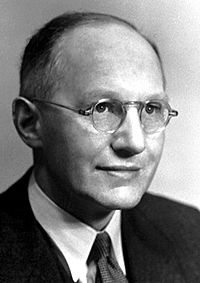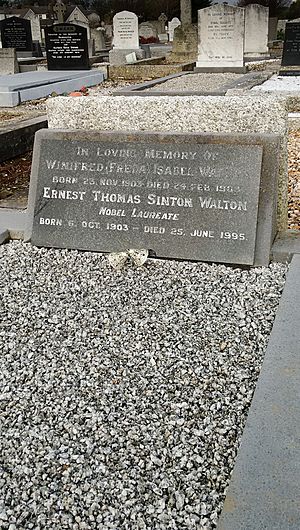Ernest Walton facts for kids
Quick facts for kids
Ernest Walton
|
|
|---|---|

Walton in 1951
|
|
| Born | 6 October 1903 Abbeyside, Waterford, Ireland
|
| Died | 25 June 1995 (aged 91) Belfast, Northern Ireland
|
| Alma mater | Trinity College Dublin Trinity College, Cambridge |
| Known for | The first disintegration of an atomic nucleus by artificially accelerated protons ("splitting the atom") |
| Awards | Hughes Medal (1938) Nobel Prize in Physics (1951) |
| Scientific career | |
| Fields | Physics |
| Institutions | Trinity College Dublin University of Cambridge Methodist College Belfast Dublin Institute for Advanced Studies |
| Doctoral advisor | Ernest Rutherford |
Ernest Thomas Sinton Walton (born October 6, 1903 – died June 25, 1995) was an Irish physicist. He won the Nobel Prize in Physics. He is famous for his work with John Cockcroft. They built one of the first particle accelerators, called the Cockcroft–Walton generator.
In the early 1930s, at Cambridge University, Walton and Cockcroft used this machine. They were the first to use a beam of tiny particles to change one element into another. This was a huge step in science. Their Nobel Prize award said they produced a "nuclear transmutation" (changing an atom's core) completely under human control. This is often called "splitting the atom."
Contents
Early Life and Education
Ernest Walton was born in Abbeyside, Dungarvan, County Waterford, Ireland. His father was a Methodist minister. Because of his father's job, Ernest's family moved often. They lived in places like Rathkeale, County Limerick, and County Monaghan. His mother passed away when he was very young.
Ernest went to different schools in Down and Tyrone. He also attended Wesley College Dublin. In 1915, he became a boarder at Methodist College Belfast. There, he was excellent in science and mathematics.
University Studies
In 1922, Ernest won scholarships to Trinity College Dublin. He studied mathematics and science there. He earned his bachelor's degree in 1926 and his master's degree in 1927. During his time at Trinity, he won many awards for his skills in physics and math.
After graduating, he received a special research fellowship. This allowed him to become a research student at Trinity College, Cambridge. His supervisor was Sir Ernest Rutherford. Rutherford was the director of Cambridge University's Cavendish Laboratory. This lab was a very important place for science. Many Nobel Prize winners worked there, including Walton and John Cockcroft. Ernest Walton earned his PhD in 1931. He continued his research at Cambridge until 1934.
Splitting the Atom
In the early 1930s, Ernest Walton and John Cockcroft worked together. They built a machine to split the nuclei (centers) of lithium atoms. They did this by shooting a stream of protons (tiny particles) at them. These protons were sped up inside a high-voltage tube. The machine used 700,000 volts of electricity!
When the lithium nuclei split, they created helium nuclei. This experiment proved theories about how atoms are built. Scientists like Rutherford and George Gamow had suggested these ideas earlier.
The successful machine they built is now called the Cockcroft-Walton generator. It was a type of particle accelerator. This invention helped start a new age of nuclear physics research. This important work at Cambridge led to Walton and Cockcroft winning the Nobel Prize in Physics in 1951.
Career at Trinity College Dublin
In 1934, Ernest Walton returned to Ireland. He became a Fellow in the physics department at Trinity College Dublin. In 1946, he became the Erasmus Smith's Professor of Natural and Experimental Philosophy.
Walton was known as an amazing lecturer. He could explain difficult science topics in simple, easy-to-understand ways. Even with limited tools, he continued his research. In the late 1950s, he studied how certain glasses glowed in the dark (phosphorescence). He also researched how electrons are released from surfaces and how to use radiocarbon dating.
Walton was also involved with the Dublin Institute for Advanced Studies for over 40 years. He served on the board of the School of Cosmic Physics. After the first chairman, John J. Nolan, passed away in 1952, Walton took over that role until 1960.
Later Years and Legacy
Ernest Walton retired from Trinity College Dublin in 1974. However, he stayed connected with the Physics Department until he became ill. Before he passed away, he gave his Nobel medal and award paper to Trinity College. This showed his lifelong dedication to the college.
Ernest Walton died in Belfast on June 25, 1995, at the age of 91. He is buried in Deansgrange Cemetery in Dublin.
Family Life
Ernest Walton married Winifred Wilson in 1934. She was also the daughter of a Methodist minister. They had four children: Alan Walton, Marian Woods, Philip Walton, and Jean Clarke. Alan and Philip both became physicists.
Religious Views
Ernest Walton was raised as a Methodist. He was very committed to his Christian faith. After winning the Nobel Prize, he gave talks in many countries. He spoke about how science and religion can work together. He believed that scientific progress could help us learn more about God.
After his death, an organization called Christians in Science Ireland started the Walton Lectures on Science and Religion. These lectures are given at universities across Ireland.
Walton also helped create the Irish Pugwash group. This group worked against the nuclear weapons race.
Honours and Recognition
Ernest Walton and John Cockcroft received the 1951 Nobel Prize in Physics. They were honored for their "work on the transmutation of the atomic nuclei by artificially accelerated atomic particles." This is commonly known as splitting the atom. They were the first to break apart a lithium nucleus using fast-moving protons. They also identified helium nuclei as a result of this process in 1930.
In 1938, Walton and Cockcroft also received the Hughes Medal from the Royal Society of London. After he retired in 1974, Walton received many honorary degrees from universities in Ireland, Britain, and North America.
His hometown of Dungarvan dedicated the "Walton Causeway Park" in his honour in 1989. Walton himself attended the ceremony. The Waterford Institute of Technology named a building the ETS Walton Building. A plaque was also placed at his birthplace.
Other honors include the Walton Building at Methodist College Belfast, where he was a student. Wesley College in Dublin, where he also studied, created the Walton Prize for Physics. A similar prize is given at Methodist College to the top physics student. There is also a scholarship in Waterford named after him. In 2014, Trinity College Dublin started the Trinity Walton Club. This is a special science and math club for teenagers.
See also
 In Spanish: Ernest Walton para niños
In Spanish: Ernest Walton para niños


